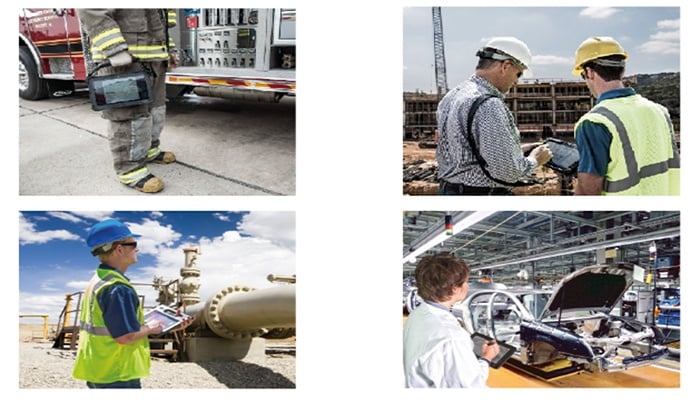Rugged Decoded: What level of rugged is right for your engineers?
Aug 29, 2016 • Features • Hardware • hardware • rugged • Rugged Decoded
Rugged comes in many different flavours from Business Rugged to Ultra Rugged. In the latest feature in our Rugged Decoded series Kris Oldland takes a look at each of the main different classes of rugged devices and outlines what level of rugged is right for your field technicians...
As we continue our series looking at the various elements that define what makes a rugged device rugged, and try to decipher what the various alpha numeric codes and other associated technical jargon actually mean in reality, we now turn our attention to perhaps one of the most confusing areas of terminology – namely rugged definitions.
So let’s take a broad look at what exactly companies mean by the terms semi-rugged, business rugged, fully rugged and ultra rugged, highlighting examples of each asset class, and their possible use cases.
Business Rugged:
The business rugged device is the first entry into the rugged sector, although business rugged devices essentially offer little more protection and reliability than a consumer device in protective casings. Generally business rugged devices are designed for travel use, but are not sealed and prepared in the same manner as a semi-rugged or fully rugged device.
A business rugged device will have shock mounted hard disk drives and magnesium casings, to protect them from light drops and knocks but they are not waterproofed and sealed. They can survive a small fall, but not necessarily a drop of greater than 18 inches.
They do, however, tend to have the most flexibility of rugged devices when it comes to style and performance, since a greater range of parts can be used as part of their design. A business rugged device is a generally regarded as being geared towards traveling executives and other people who will be on the road often, but who will not be using their device as part of fieldwork on a regular basis. Therefore business rugged devices are not ideally suited for most field service roles.
Semi-Rugged:
A semi-rugged device is a standard notebook, smartphone or tablet that has been adapted to rugged use.
Semi-rugged devices will have gone through a process known as ruggedization. This will includes giving them a magnesium case, a shock or gel-mounted hard disk drive, and a spill-proof keyboard.
Such devices are able to withstand reasonably high and low temperatures ranges, however they may suffer a decrease in performance in those environments. For example, the gel in the screen might freeze at very cold temperatures, reducing visibility for a short period of time.
Semi-rugged devices are still very good for travel and outdoor use, and are best for people who travel often and need to occasionally work outside, but who don’t want the higher cost of a fully rugged laptop.
Therefore, they can be a good option for field engineers who are largely working in indoor client sites, such as those working in office based maintenance and repair sectors like print services, vending machine repair or IT infrastructure.
Fully Rugged:
A fully rugged device has been designed from the ground up with one overall purpose in mind: to be able to function anywhere, even in outdoor, dusty, or extreme weather conditions.
Each component is carefully weatherproofed and sealed to prevent salt, sand, moisture, or other environmental hazards from affecting it. The screens are specially designed to reduce glare, making it possible to use the device outdoors and in bright sunlight.
These devices can typically withstand freezing temperatures and heat up to 120 degrees Fahrenheit and are able to still function without a significant reduction in operating performance in a greater range of temperatures than a semi-rugged device.
Fully rugged devices will also generally have been tested to MIL STD 801G which will include drop testing across numerous different angles from a set height, which means that the device is capable of withstanding most drops and knocks likely to occur in a a field service engineers day.
Fully rugged devices are ideally suited for field engineers working outdoors and in more challenging environments such as those in utilities, construction, oil and gas or anybody else who is likely to need a computer outside and in an extreme working environment.
Ultra Rugged:
Ultra rugged devices are the most rugged devices available. They are tested to be able to withstand even greater drops, be fully submersible and impervious to dust ingress and are essentially able to operate within the most inhospitable environments on Earth with little to no reduction in operational performance.
Generally for most field service requirements ultra rugged devices are perhaps a touch of overkill as they are generally designed primarily for military use, however, field technicians working in environments such as deserts or at sea including oil rigs might also want the uncompromising reliability that an ultra rugged device can provide.





















 Field Service News is published by 1927 Media Ltd, an independent publisher whose sole focus is on the field service sector. As such our entire resources are focused on helping drive the field service sector forwards and aiming to best serve our industry through honest, incisive and innovative media coverage of the global field service sector.
Field Service News is published by 1927 Media Ltd, an independent publisher whose sole focus is on the field service sector. As such our entire resources are focused on helping drive the field service sector forwards and aiming to best serve our industry through honest, incisive and innovative media coverage of the global field service sector.
Leave a Reply